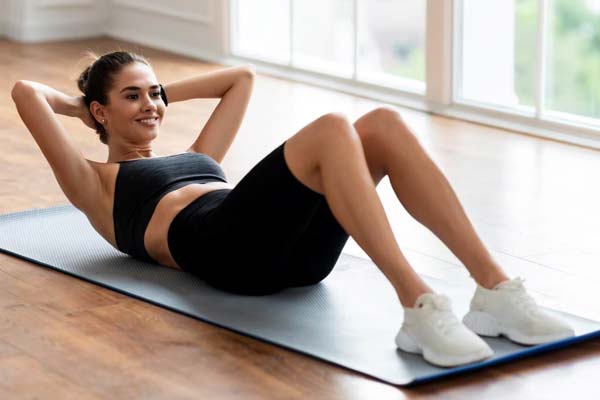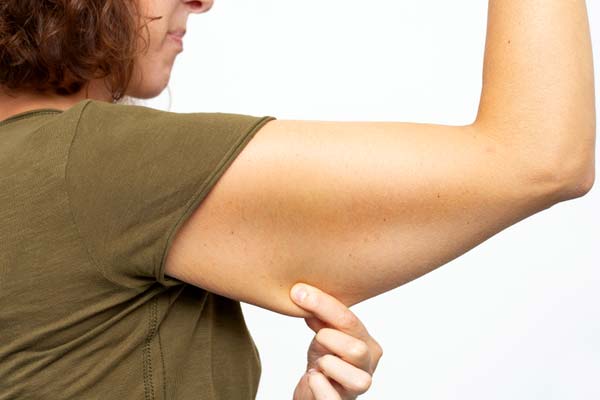تمارين الكرنش والسيت أب: أيهما أفضل؟
تتساءل العديد من الأشخاص عن الفرق بين التمارين الرياضية “الكرانش” و”السيت أب”، والتي تستهدفان تقوية عضلات البطن. وبالرغم من أن هذين التمرينين يستخدمان نفس المجموعة العضلية، إلا أنهما يختلفان في الطريقة التي يتم من خلالها تنفيذهما والتأثير الذي يتركانه على الجسم. وبالتالي، يعتبر الاختيار بين الكرانش والسيت أب قرارًا شخصيًا يعتمد على الهدف الذي يريد الفرد تحقيقه.
تعد التمارين الرياضية “الكرانش” أكثر شيوعًا بين الأشخاص الذين يريدون تقوية عضلات البطن، حيث تركز هذه التمارين على عضلات البطن الأمامية العليا والوسطى. وتتميز التمارين بأنها سهلة التنفيذ وتحتاج إلى مساحة صغيرة للتمرين، كما أنها لا تؤدي إلى الإصابة بآلام في الظهر.
بالمقابل، يعد التمرين “السيت أب” أكثر صعوبة من الكرانش ويتطلب مجهودًا أكبر لتنفيذه. ويتميز هذا التمرين بتقوية عضلات البطن العميقة والتي تدعم الظهر، كما أنه يمكن أن يؤدي إلى الإصابة بآلام في الظهر إذا لم يتم تنفيذه بشكل صحيح. وبالرغم من أنه أقل شيوعًا من التمارين الكرانش، إلا أنه يعد خيارًا جيدًا للأشخاص الذين يرغبون في تحقيق تقوية عضلات البطن العميقة.
الفرق بين الـ Crunches والـ Sit-Ups
تعد الـ Crunches والـ Sit-Ups من التمارين التي تستخدم لتقوية العضلات في منطقة البطن. ومع ذلك ، فإن هناك فرقًا بين الاثنين يجب على المرء معرفته عندما يختار التمرين المناسب له.
الفرق الرئيسي
الفرق الرئيسي بين الـ Crunches والـ Sit-Ups هو نطاق الحركة المشارك في كل تمرين. حيث أن الـ Sit-Ups يتطلب من الشخص القيام برفع كامل للجسم ، بينما يتطلب الـ Crunches رفعًا طفيفًا عن الأرض. يمكن للـ Sit-Ups تنشيط المزيد من العضلات من الـ Crunches ، ولكن قد يشكلوا مخاطر أكبر للإصابة.
الفوائد والعيوب
تعتبر الـ Crunches أكثر فعالية وكفاءة في تقوية عضلات البطن وهي مناسبة لفئة أوسع من الأشخاص. بينما يمكن أن تؤدي الـ Sit-Ups إلى إصابة الظهر وتكون صعبة على عضلات الرقبة والمفاصل الوركية ، فإن الـ Crunches تعزل العضلات بشكل أكبر.
من المهم الاهتمام بتقنية التمرين وتجنب الإفراط في الحركة والحفاظ على الوضعية الصحيحة للجسم خلال التمرين.
بشكل عام ، يعتمد اختيار التمرين على الأهداف الشخصية والقدرة البدنية. يمكن للشخص استشارة مدرب شخصي للمساعدة في اختيار التمرين المناسب له.
فوائد الـ Crunches
تُعد الـ Crunches تمرينًا شائعًا لتقوية عضلات البطن، ولها العديد من الفوائد، ومنها:
- تعزيز عضلات البطن: يعتبر هذا التمرين فعالًا لتقوية عضلات البطن، وخصوصًا عضلة العرض الذاتي والعضلة المستقيمة الأمامية.
- تحسين التوازن والاستقرار: يُعتبر الـ Crunches تمرينًا مفيدًا لتحسين التوازن والاستقرار، وذلك نظرًا للحاجة إلى الاستقرار أثناء تنفيذ التمرين.
- تحسين المرونة: يمكن تنفيذ الـ Crunches بأساليب مختلفة، مما يُمكن تحسين المرونة وتوسيع نطاق الحركة.
- تقليل الإصابة بآلام الظهر: يمكن تنفيذ الـ Crunches بشكل صحيح وآمن، مما يُقلل من خطر الإصابة بآلام الظهر.
ينبغي أن يتم تنفيذ التمرين بشكل صحيح وبتقنية جيدة، ويجب تجنب الإفراط في العدد والتركيز على الحركة الصحيحة بدلاً من زيادة العدد.
فوائد الـ Sit-Ups
تُعد الـ Sit-Ups من التمارين الرياضية الشهيرة والفعالة في تقوية عضلات البطن وحرق الدهون في هذه المنطقة. وبالرغم من أنها لا تستهدف الدهون بشكل مباشر، إلا أنها تساعد على تقوية العضلات في البطن وتحسين مظهرها.
وتتميز الـ Sit-Ups بعدة فوائد، منها:
- تقوية عضلات البطن: حيث تعمل الـ Sit-Ups على تنشيط عضلات البطن وتقويتها، مما يساعد على تحسين مظهر هذه المنطقة وتقليل ترهلها.
- تحسين اللياقة البدنية: حيث تعمل الـ Sit-Ups على تحسين اللياقة البدنية بشكل عام، وتزيد من قدرة الجسم على تحمل الأنشطة اليومية.
- تحسين الوضعية الجسدية: حيث تعمل الـ Sit-Ups على تحسين الوضعية الجسدية وتقوية عضلات الظهر، مما يساعد على تقليل خطر الإصابة بآلام الظهر.
- تحسين الهضم: حيث تعمل الـ Sit-Ups على تحفيز الدورة الدموية في منطقة البطن، مما يساعد على تحسين عملية الهضم والامتصاص.
- تحسين التوازن الجسدي: حيث تعمل الـ Sit-Ups على تحسين التوازن الجسدي وتقوية عضلات الأرجل والأرداف، مما يساعد على تحسين القدرة على القيام بالأنشطة اليومية بسهولة.
بشكل عام، تُعد الـ Sit-Ups تمرينًا رياضيًا فعالًا في تقوية عضلات البطن وتحسين اللياقة البدنية، ويُمكن إضافتها إلى البرنامج الرياضي اليومي للحصول على أفضل النتائج.
التمارين المرتبطة بالـ Crunches
تمارين الـ Crunches الجانبية
تعتبر تمارين الـ Crunches الجانبية من التمارين الفعالة في تقوية عضلات الجانبين والخصر. وتتمثل هذه التمارين في القيام بحركة الـ Crunches العادية، ولكن بالإضافة إلى ذلك، يتم رفع الكتفين والرأس في اتجاه الجانب الأيسر، ثم الجانب الأيمن بالتناوب. ويمكن استخدام الأوزان الخفيفة لزيادة تحدي الحركة وتقوية العضلات بشكل أفضل.
تمارين الـ Crunches الأمامية
تتمثل تمارين الـ Crunches الأمامية في القيام بحركة الـ Crunches العادية، ولكن بالإضافة إلى ذلك، يتم رفع الجزء العلوي من الجسم بشكل مائل إلى الأمام باتجاه الركبتين. ويمكن استخدام الأوزان الخفيفة لزيادة تحدي الحركة وتقوية العضلات بشكل أفضل.
تمارين الـ Crunches الخلفية
تتمثل تمارين الـ Crunches الخلفية في القيام بحركة الـ Crunches العادية، ولكن بالإضافة إلى ذلك، يتم رفع الجزء العلوي من الجسم بشكل مائل إلى الخلف باتجاه الأرض. ويمكن استخدام الأوزان الخفيفة لزيادة تحدي الحركة وتقوية العضلات بشكل أفضل.
يمكن لتمارين الـ Crunches أن تساعد في تقوية عضلات البطن، بما في ذلك العضلات الجانبية والخلفية، وتحسين القدرة على القيام بحركات الجسم اليومية بشكل أفضل. كما أن تمارين الـ Crunches تساعد في تحسين المرونة وزيادة نطاق الحركة في منطقة البطن. ومع ذلك، يجب الانتباه إلى عدم الإفراط في ممارسة هذه التمارين، حيث يمكن أن تؤدي إلى آلام الظهر والرقبة إذا تم تنفيذها بشكل غير صحيح.
التمارين المرتبطة بالـ Sit-Ups
تمارين الـ Sit-Ups العادية
تعتبر تمارين الـ Sit-Ups العادية من التمارين الأساسية الشائعة التي يستخدمها الكثيرون لتقوية عضلات البطن. وتتمثل هذه التمارين في الاستلقاء على الظهر وثني الركبتين ووضع الأيدي خلف الرأس، ثم رفع الصدر والجسم باتجاه الركبتين. وتعتمد فعالية هذه التمارين على تمركز الضغط على العضلات الأمامية للبطن.
وتعتبر تمارين الـ Sit-Ups العادية مفيدة لتقوية عضلات البطن وتحسين الثبات الأساسي وزيادة مدى الحركة في الوركين. كما أنها تعمل على تقوية عضلات الصدر والكتفين والفخذين.
تمارين الـ Sit-Ups المرتفعة
تتميز تمارين الـ Sit-Ups المرتفعة بالمزيد من الصعوبة والتحدي، حيث يتم رفع الجزء العلوي من الجسم إلى الأمام والأعلى بشكل متزامن. وتتطلب هذه التمارين استخدام العضلات الأمامية للبطن بشكل أكبر، مما يزيد من قوة هذه العضلات.
وتساعد تمارين الـ Sit-Ups المرتفعة على تحسين الثبات الأساسي وزيادة مدى الحركة في الوركين وتقوية عضلات الصدر والكتفين والفخذين. كما أنها تعمل على تحسين مرونة العضلات الأمامية للبطن وتعزيز العزلة العضلية.
ومن المهم الانتباه إلى الشكل الصحيح لتمارين الـ Sit-Ups المرتفعة، حيث يجب الحرص على تثبيت القدمين بشكل جيد وتفادي الحركات الزائدة للكتفين والرقبة.
المخاطر المرتبطة بالـ Crunches
تعد Crunches تمارين رائعة لتقوية عضلات البطن، ولكن يمكن أن تكون لها بعض المخاطر المرتبطة بها. يجب على الأشخاص الذين يعانون من مشاكل في الظهر أو الرقبة أو العمود الفقري أو الوركين تجنب هذه التمارين. ومع ذلك، إذا تم تنفيذ التمارين بشكل صحيح، فإنها يمكن أن تساعد في تقوية عضلات البطن وتحسين الاستقرار الأساسي.
من بين المخاطر المرتبطة بالـ Crunches هي آلام الظهر. إذا لم يتم تنفيذ التمارين بشكل صحيح، فإنه يمكن أن يتسبب في آلام الظهر. ويمكن تجنب هذه المشكلة عن طريق استخدام الأسلوب الصحيح للقيام بالتمارين والتأكد من عدم الإفراط في الحركة.
كما يمكن أن يؤدي القيام بالـ Crunches بشكل غير صحيح إلى آلام في الرقبة والعمود الفقري. ومن الأفضل تجنب هذه المشكلة عن طريق استخدام الأسلوب الصحيح للقيام بالتمارين وتجنب الإفراط في الحركة.
يمكن أن يؤدي القيام بالـ Crunches بشكل غير صحيح إلى إصابات في الوركين والعمود الفقري. ومن الأفضل تجنب هذه المشكلة عن طريق استخدام الأسلوب الصحيح للقيام بالتمارين وتجنب الإفراط في الحركة.
عند القيام بالـ Crunches، يجب الانتباه إلى الاستقرار والتوازن. ويمكن زيادة الاستقرار والتوازن عن طريق تقوية عضلات الظهر والوركين. ويمكن تجنب هذه المشكلة عن طريق استخدام الأسلوب الصحيح للقيام بالتمارين وتجنب الإفراط في الحركة.
قد ينصح بعض المدربين الشخصيين بتجنب الـ Crunches للمبتدئين والأشخاص الذين يعانون من مشاكل في الظهر. وبدلاً من ذلك، يمكن تجربة تمارين الـ Planks أو القيام بالـ Crunches بطريقة مختلفة. يمكن الاستفادة من نصائح المدربين الشخصيين لتعلم كيفية القيام بالـ Crunches بطريقة صحيحة وتجنب المخاطر المرتب
المخاطر المرتبطة بالـ Sit-Ups
تعتبر تمارين الـ Sit-Ups من التمارين الأكثر شيوعًا لتقوية العضلات الأساسية، ولكن يمكن أن تسبب هذه التمارين بعض المخاطر على الصحة. فيما يلي بعض المخاطر المحتملة المرتبطة بممارسة تمارين الـ Sit-Ups:
- الإصابة: يمكن لتمارين الـ Sit-Ups أن تؤدي إلى الإصابة بآلام الظهر والرقبة إذا لم يتم تنفيذها بشكل صحيح. ويمكن تجنب هذه المشكلة عن طريق الحفاظ على الوضعية الصحيحة وتجنب استخدام العضلات الأخرى للمساعدة في رفع الجسم.
- آلام الظهر: يمكن أن يؤدي تمرين الـ Sit-Ups إلى آلام الظهر إذا لم يتم تنفيذه بشكل صحيح. ولتجنب هذه المشكلة، يجب عليك تجنب القيام بتمارين الـ Sit-Ups إذا كان لديك مشكلة في الظهر.
- ضعف العضلات الأساسية: يمكن لتمارين الـ Sit-Ups أن تؤدي إلى ضعف العضلات الأساسية إذا لم يتم تنفيذها بشكل صحيح. لتجنب هذه المشكلة، يجب عليك الحفاظ على وضعية الجسم الصحيحة وتجنب استخدام العضلات الأخرى للمساعدة في رفع الجسم.
يمكن تجنب هذه المشكلات عن طريق ممارسة التمارين بشكل صحيح والحفاظ على وضعية الجسم الصحيحة. كما يمكن تجنب هذه المشكلات عن طريق تجنب تمارين الـ Sit-Ups إذا كان لديك مشكلة في الظهر.
الخلاصه
تعتبر تمارين البطن من التمارين الأساسية التي يجب أن يقوم بها الشخص ضمن روتينه الرياضي اليومي، وتتضمن هذه التمارين الكثير من الحركات الرياضية المختلفة، ومن بينها تمارين الكرانش وتمارين السيت أب، واللتان تعملان على تقوية عضلات البطن.
تتميز تمارين الكرانش بأنها تستهدف عضلات البطن بشكل أكبر وتحتاج إلى مجهود أقل من تمارين السيت أب، كما أنها تساعد على تحسين قدرة البطن على التحمل وتقوية العضلات المحيطة به.
أما تمارين السيت أب فتتطلب مجهودًا أكبر من تمارين الكرانش، وتعمل على تقوية عدد أكبر من العضلات بما فيها العضلات المحيطة بالبطن، ويمكن تنويع هذه التمارين بإضافة الأثقال لتحقيق نتائج أفضل.
بالنهاية، يعتمد اختيار التمارين المناسبة على أهداف كل شخص وما يريد تحقيقه من رياضة اللياقة البدنية، ولكن من الأفضل أن يتم تضمين كلا التمرينين ضمن الروتين الرياضي اليومي لتحقيق أفضل النتائج وتنويع التمارين.






